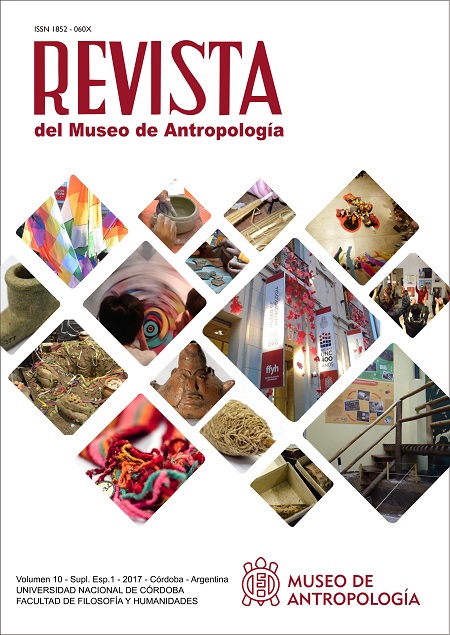Characterization of the ceramic record from Barranca I site (Dpto. Río Cuarto, Córdoba)
DOI:
https://doi.org/10.31048/1852.4826.v10.n0.13523Keywords:
pre-hispanic ceramics, Sierra de Comechingones, macroscopic analysis, iconography, antiplasticsAbstract
This paper exposed the initial results of the ceramic analysis of the Component 1 from the site Barranca I, dated 2677 LP- 290 ± 50 years BP, located in the area of the foothills of the eastern section of the Sierra de Comechingones (Dept. Río Cuarto, Córdoba, Argentina). Technological, morphological, functional and stylistic aspects of a record characterized by the homogeneity of ceramic pastas at the macroscopic level and a high degree of fragmentation of the pots are considered here. The objective of the analysis of these materials was obtain an approximate the behavior of these societies with respect to patterns of manufacture and use of the various ceramic containers, according to the ambient environment of espinal.Downloads
References
Austral, A. & A. Rocchietti. 2004. Al sur del río Cuarto: Síntesis de la Arqueología Regional. En: Bechis, M. (Comp.) Terceras Jornadas de Arqueología Histórica y de Contacto del Centro Oeste de la Argentina Seminario de Etnohistoria. Cuartas Jornadas de Arqueología y Etnohistoria del Centro Oeste del País. Universidad Nacional de Río Cuarto. Río Cuarto. Pp. 97- 114.
Cremonte, M. B. & M. F. Bugliani. 2006-2009. Pasta, forma e iconografía. Estrategias para el estudio de la cerámica arqueológica. Xama 19-23:239-262.
Dantas, M. & G. Figueroa. 2008. Análisis tecnológico y funcional del registro cerámico del Valle de Salsacate y Pampas de altura adyacentes (Provincia de Córdoba, República Argentina). British Archaeological Reports, International Series S1869. Oxford.
Fabra, M. & A. Laguens. 1999. Análisis tecnológico de improntas de cestería en fragmentos cerámicos de Córdoba, Argentina. En Actas del XII Congreso Nacional de Arqueología Argentina. La Plata. Tomo II. 25-34.
Figueroa, G.; E. Pautassi & M. Dantas. 2011. Técnicas cesteras y cerámica arqueológica de las Sierras Centrales de Córdoba, República Argentina. ArqueoWeb. Revista sobre Arqueología en Internet 13:15-31.
García Roselló, J. & M. Calvo Trias. 2006. Análisis de las evidencias macroscópicas de cocción en la cerámica prehistórica: una propuesta para su estudio. Mayurqa (31): 83-112.
Hally, D. J. 1986. The identification of vessel function: A case study from Northwest Georgia. American Antiquity 51 (2): 267:295
Henrickson, E. F. & M. M. McDonald. 1983. Ceramic Form and Function: an ethnographic search and archaeological application. American Antiquity 51 (2): 267-295.
López Campeny, S. 2011. La impresión es lo que cuenta…análisis de improntas textiles. Casos arqueológicos para Santiago del Estero. Relaciones de la Sociedad Argentina de Antropología XXXVI: 221-247.
Medina, M.; S. Pastor & E. Berberián. 2014. Es gente fazil de moverse de una parte a otra. Diversidad en las estrategias de subsistencia y movilidad prehispánicas tardías (Sierras de Córdoba, Argentina). Complutum 25 (1): 73.88.
Meggers, B. & C. Evans. 1969. Como interpretar el lenguaje de los tiestos. Smithsonian Institution.
Oyama, M. & H. Takehara. 1970. Revised standard soil color charts. Revised Edition Japan Colour Research Institute. Tokyo.
Pastor, S. 1999. Forma y función de las vasijas de San Roque (Dpto. Punilla, Pcia de Córdoba). En Actas del XII Congreso Nacional de Arqueología Argentina. La Plata. Tomo III. Pp. 511-516.
Pastor, S. & M. Medina. 2013. Prácticas resistentes, elusión y reproducción social en un contexto histórico adverso. Una mirada a los indígenas de Córdoba (Argentina) en tiempos Coloniales Tempranos. Memoria Americana. Cuadernos de Etnohistoria 21 (1): 66-92.
Rice, P. M. 1987. Pottery Analysis: a sourcebook. University of Chicago Press. Chicago.
Rocchietti, A. 1984. Ordenes de la clasificación arqueológica: sus fundamentos ideográficos y nomotéticos. Revista UNRC (1): 75-112.
Rocchietti, A. & F. Ribero 2015a. “Fechados radiocarbónicos y distribuciones arqueológicas en localidades de la Sierra de Comechingones (provincial de Córdoba)”. En Pifferetti, A. & I. Dosztal (Comps.) Arqueometría Argentina. Metodologías científicas aplicadas al estudio de los bienes culturales: datación, caracterización, prospección y conservación. Aspha. Buenos Aires.
Rocchietti, A. & F. Ribero 2015b. Sitio Barranca I: Sistemática estratigráfica de depósito Ceramolítico en el piedemonte de la Sierra de Comechingones, provincia de Córdoba. Trabajo presentado en el VI Congreso Nacional de Arqueometría. Río Cuarto, Diciembre de 2015. Inédito.
Rocchietti, A., M. Tamagnini, E. Olmedo, G. Perez Zavala, F. Ribero, A. Ponzio, L. Alaniz, D. Reinoso, A. Cavallin, P. Altamirano & A. Ponce. 2013. La formación del territorio surcordobés a través de su potencial arqueológico. Plan director Achiras histórica. Revista cultura en red. I (I): 101-131.
Shepard, A. O. 1985. Ceramics for the archaeologist. Carnegie Institute of Washington.
Downloads
Published
Issue
Section
License
Those authors who have publications with this Journalaccept the following terms:
a. Authors will retain their copyrights and guarantee the journal the right of first publication of their work, which will be simultaneously subject to the Creative Commons Attribution License (Licencia de reconocimiento de Creative Commons) that allows third parties to share the work as long as its author and his first publication in this journal.
b. Authors may adopt other non-exclusive licensing agreements for the distribution of the version of the published work (eg, deposit it in an institutional electronic file or publish it in a monographic volume) provided that the initial publication in this journal is indicated.
c. Authors are allowed and recommended to disseminate their work on the Internet (eg in institutional telematic archives or on their website) before and during the submission process, which can lead to interesting exchanges and increase citations of the published work. (See The Effect of Open Access - El efecto del acceso abierto)












